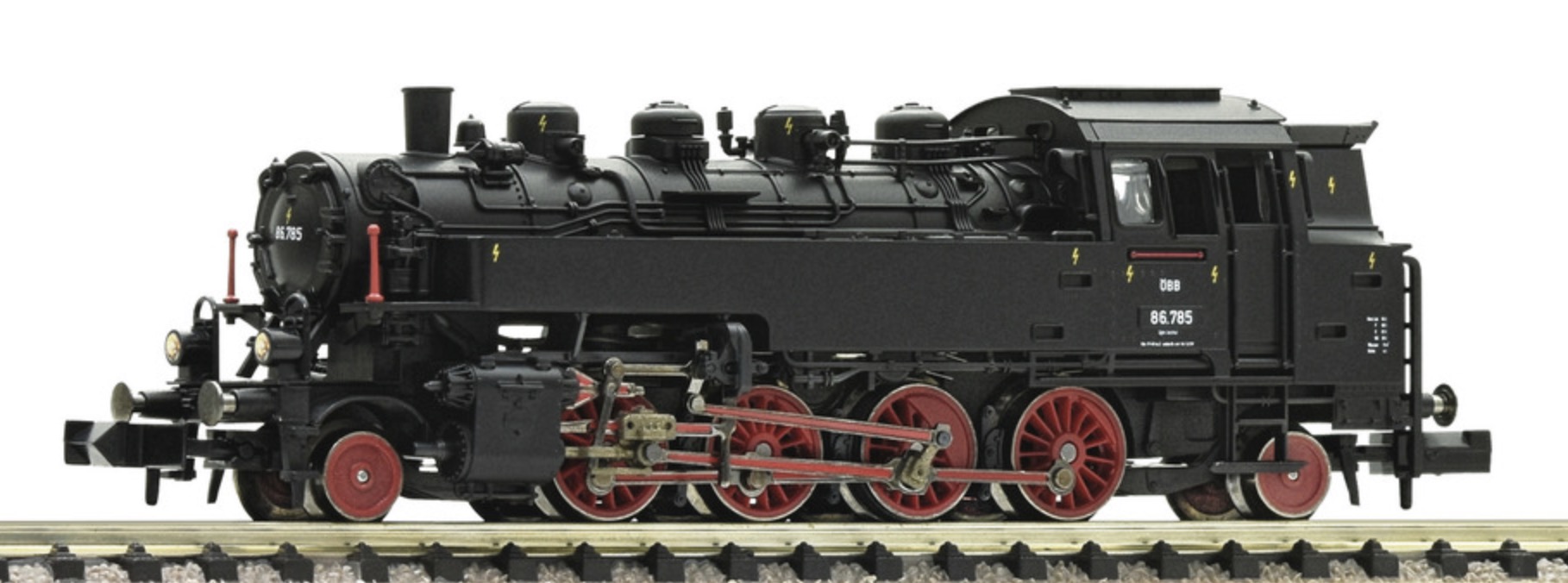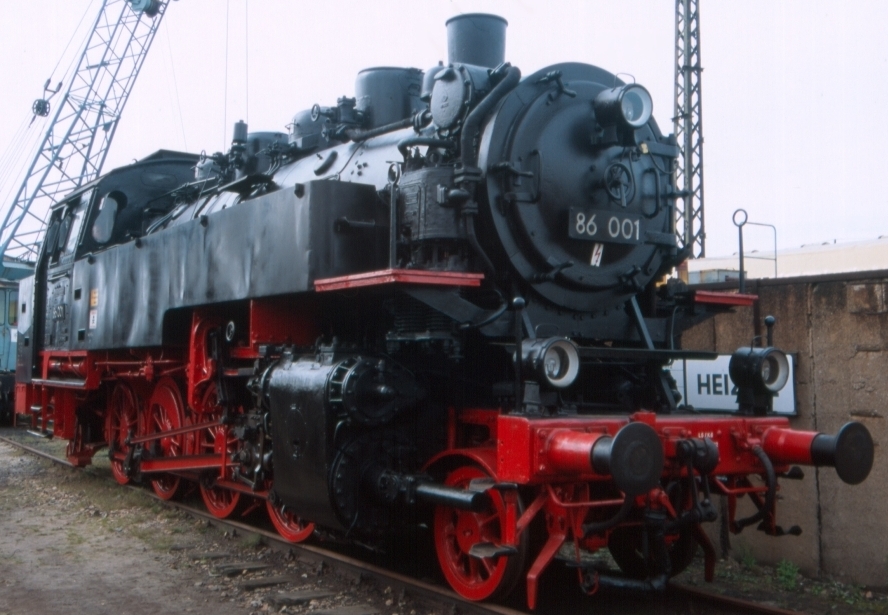Prototype History: The DRG Class 86 was a standard (see Einheitsdampflokomotive) goods train tank locomotive with the Deutsche Reichsbahn-Gesellschaft. It was intended for duties on branch lines and was delivered by almost all the locomotive building firms working for the Reichsbahn. From 1942 it was built in a simplified version as a 'transitional war locomotive' (Übergangskriegslokomotive or ÜK). The most obvious changes were the omission of the second side windows in the cab and the solid disc carrying wheels.
Almost all German locomotive factories took part in building these engines, 775 examples being produced in the period from 1928 to 1943. Its area of operations was predominantly the routes in Germany's central mountains (Mittelgebirge); as a result the first 10 units were given a Riggenbach counter-pressure brake. Twenty locomotives were destroyed during the Second World War; lightly damaged engines were repaired. Of the original 775 units, 175 went to the GDR railways, 385 to the Deutsche Bundesbahn, 29 to the Austrian Federal Railways (ÖBB), 44 to the PKP in Poland as the Class TKt3, 73 to the SZD and 62 to the CSD (6 of which later went to the SZD and 86 043 in 1958 to the GDR). On the last-mentioned 62 engines 28 became the CSD Class 455.2. Only 2 engines are still unaccounted for (86 016 and 86 469). The ÖBB began to retire them as early as 1945, but the last did not retire until 1972. However the Austrian engines had some of the most spectacular duties, including working double-headed on heavy, empty, ore trains with a DRB Class 52.
Almost all German locomotive factories took part in building these engines, 775 examples being produced in the period from 1928 to 1943. Its area of operations was predominantly the routes in Germany's central mountains (Mittelgebirge); as a result the first 10 units were given a Riggenbach counter-pressure brake. Twenty locomotives were destroyed during the Second World War; lightly damaged engines were repaired. Of the original 775 units, 175 went to the GDR railways, 385 to the Deutsche Bundesbahn, 29 to the Austrian Federal Railways (ÖBB), 44 to the PKP in Poland as the Class TKt3, 73 to the SZD and 62 to the CSD (6 of which later went to the SZD and 86 043 in 1958 to the GDR). On the last-mentioned 62 engines 28 became the CSD Class 455.2. Only 2 engines are still unaccounted for (86 016 and 86 469). The ÖBB began to retire them as early as 1945, but the last did not retire until 1972. However the Austrian engines had some of the most spectacular duties, including working double-headed on heavy, empty, ore trains with a DRB Class 52.
Road Name History:  The Austrian Federal Railways (German: Österreichische Bundesbahnen or ÖBB, formerly the Bundesbahn Österreich or BBÖ) is the national railway system of Austria, and the administrator of Liechtenstein's railways. The ÖBB group is owned entirely by the Republic of Austria and is divided into several separate businesses that manage the infrastructure and operate passenger and freight services.
The Austrian Federal Railways (German: Österreichische Bundesbahnen or ÖBB, formerly the Bundesbahn Österreich or BBÖ) is the national railway system of Austria, and the administrator of Liechtenstein's railways. The ÖBB group is owned entirely by the Republic of Austria and is divided into several separate businesses that manage the infrastructure and operate passenger and freight services.
The Austrian Federal Railways has had two discrete periods of existence. It was first formed in 1923, using the Bundesbahn Österreich name, as a successor to the Imperial Royal Austrian State Railways (kkStB), but was incorporated into the Deutsche Reichsbahn during the 1938-1945 Anschluss. It was reformed in 1947, using the slightly different Österreichische Bundesbahnen name, and remains in existence in this form.
Major changes currently being made to the Austrian railway network are the construction of the Wien Hauptbahnhof (Vienna main station), the Koralm Railway, the Semmering Base Tunnel and the Brenner Base Tunnel connection with Italy.
From Wikipedia

The Austrian Federal Railways has had two discrete periods of existence. It was first formed in 1923, using the Bundesbahn Österreich name, as a successor to the Imperial Royal Austrian State Railways (kkStB), but was incorporated into the Deutsche Reichsbahn during the 1938-1945 Anschluss. It was reformed in 1947, using the slightly different Österreichische Bundesbahnen name, and remains in existence in this form.
Major changes currently being made to the Austrian railway network are the construction of the Wien Hauptbahnhof (Vienna main station), the Koralm Railway, the Semmering Base Tunnel and the Brenner Base Tunnel connection with Italy.
From Wikipedia
Brand/Importer Information: As a high-quality company we set the standard when it comes to prototype fidelity and functionality. Our aim is to enthrall novices and experts alike and to be the enduring long-term partner for a fascinating hobby that spans all generations. We achieve this with the true-to-detail design and the reliability of our models and with innovations that offer a new dimension in the play value and fun factor. The high commitment to quality that has characterised Fleischmann for more than 125 years has ensured our company?s position as an internationally leading brand for model railways.
Small-scale greatness. Its comprehensive range in the N scale makes Fleischmann the international market leader in this sector. There are over 350 highly detailed models to choose from in the space-saving 9-mm gauge. Continuous and targeted extension of the range will allow Fleischmann to expand its competitive edge in the future.
Small-scale greatness. Its comprehensive range in the N scale makes Fleischmann the international market leader in this sector. There are over 350 highly detailed models to choose from in the space-saving 9-mm gauge. Continuous and targeted extension of the range will allow Fleischmann to expand its competitive edge in the future.
Item created by: CNW400 on 2024-06-25 21:30:27. Last edited by CNW400 on 2024-06-25 21:30:28
If you see errors or missing data in this entry, please feel free to log in and edit it. Anyone with a Gmail account can log in instantly.
If you see errors or missing data in this entry, please feel free to log in and edit it. Anyone with a Gmail account can log in instantly.





